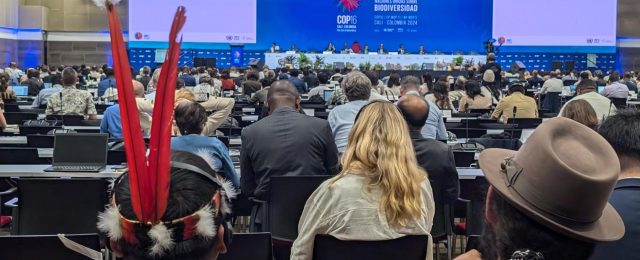COP16 reflections: the good, the bad and the unresolved

The United Nations’ Conference of the Parties or ‘COP16’ summit in Cali, Colombia, has come to a bittersweet end, leaving us with small wins, big gaps and a $700 billion question.
Some small breakthroughs were made: Indigenous communities were formally incorporated into the official decision-making of the UN biodiversity process, and a global levy was agreed on for products using genetic data from nature which will be used to fund conservation and support Indigenous communities. Their perspectives are vital, as these communities steward 40% of the world’s terrestrial protected areas and manage critical ecosystems.
Yet, critical issues remain unresolved. Three-fourths of countries missed the deadline for their National Biodiversity Strategies and Action Plans (NBSAPs), the national-level plans outlining how each country intends to fulfill its commitments under the Convention on Biological Diversity (CBD). Even more concerning, there’s still no clear plan for monitoring this decade’s biodiversity targets, and a glaring $700 billion annual funding gap for nature persists.
Despite these setbacks, COP16 drew record interest. Initially anticipating 12,000 attendees, the event swelled to 23,000 participants, leaving hotels overbooked and pushing many into unconventional accommodations. This turnout reflects growing awareness of biodiversity’s urgency, but the key question of the summit remains: where will the resources needed to bridge the nature financing gap come from?
Alongside official negotiations, a wide array of discussions unfolded, focusing on how companies can tackle biodiversity loss. Corporate and investor representatives filled several sessions, eager to understand how to measure and disclose their impact on nature. And while consensus is forming around what to measure—including impacts on ecosystems and on the communities that rely on them—how to measure it remains highly debated.
One primary hurdle is that companies crave a single biodiversity metric akin to that used in carbon accounting. However, biodiversity impacts are often local and cannot be universally aggregated. Unlike carbon, where emissions contribute globally, the impact on ecosystems varies by location. Companies must adopt a place-based approach to biodiversity, recognising that the impacts of environmental damage in one area can’t simply be offset by restoration elsewhere.
A significant breakthrough that provides useful guidance to companies was the introduction of nine indicators—four core and five site-specific indicators—to help companies gauge their biodiversity impacts, launched by the Nature Positive Initiative (NPI). These nine indicators, distilled from an original list of 600, were chosen for their credibility, science-based characteristic, and alignment with the Global Biodiversity Framework (GBF). These concrete, quantifiable metrics are essential to guard against greenwashing and prevent “nature positive” from becoming another empty buzzword.
Despite this positive development, overall, conviction from the corporate world was lukewarm. An often-repeated worry from company representatives was: “We’re already overloaded with our climate transition plans; now you want nature transition plans too?” It’s a valid concern, especially as companies are also being asked to consider social impacts, like human rights environmental due diligence. But here’s the inconvenient truth: we don’t have the luxury of solving climate change first, and worrying about biodiversity later. These crises are linked and treating them as separate battles is counterproductive.
At multiple events and roundtables co-organised by the Taskforce for Nature-Related Disclosures (TNFD), Global Reporting Initiative (GRI), CDP, and Science-Based Targets Network (SBTN), a frequently echoed message from companies and investors was feeling overwhelmed by the sheer number of standards and frameworks being developed to measure and disclose impacts on nature.
Nevertheless, it was clear that these environmental disclosure and target-setting organisations, despite publishing different sets of complementary guidance, are in continuous dialogue with each other, making significant efforts to be as aligned as possible. However, moving forward, it is important to go beyond mere alignment and instead aim towards convergence—setting out a unified set of clear, actionable expectations. Without it, we risk drowning in company reports without seeing real change.
Additionally, despite many events at COP16 making efforts to give Indigenous Peoples and Local Communities (IPLCs) a voice, none of the events I attended included them in meaningful dialogue with corporate actors. Their presence felt like a snow globe, something meant only for display— yet contained, isolated and separate from the rest of the environment around it.
The ask from IPLCs is clear: they want to be consulted and genuinely heard when corporate activities affect them. Companies need a dose of humility and a willingness to put in the work to engage them. This includes honouring Free, Prior, and Informed Consent (FPIC), as enshrined in the United Nations Declaration on the Rights of Indigenous Peoples. Respect for IPLC decisions means accepting that consent may be withheld, or negotiations may be required. Only 13% of companies assessed in our Nature Benchmark have committed to respecting Indigenous rights. A more inclusive dialogue, where Indigenous knowledge actively informs corporate conservation efforts is not optional, it’s vital.
Essential groundwork has been laid, but it’s now up to governments, businesses and civil society to translate this momentum into action. The tools exist, and the urgency is undeniable. The message to the private sector is clear: start small, prioritise material impacts and refine efforts over time. With aligned, actionable frameworks and genuine engagement with local communities, meaningful change is within reach.
The takeaway from COP16? We don’t have the luxury to wait. Biodiversity is at a tipping point. Now is the time to act—before the cost of inaction becomes irreversible. Nature can’t wait. Neither can we.